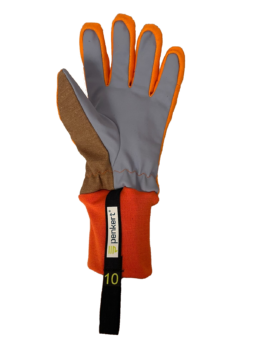Protective gloves
Service and help
Size chart for protective gloves
Length: The measurement from the first crease of the wrist to the top of the middle finger Circumference: The measurement around your hand just below the knuckles Info: A firefighting glove should have an air cushion between the hand / fingers and the actual glove. A technical assistance glove, on the other hand, should be close-fitting for optimum tactility.

Product care
Please note that not all models are washable, more information can be found inside the glove and in the technical data sheet / instructions for use.
Leather
General Use a slow and gentle program at 40°C. DetergentsUse conventional detergents. Avoid bleaching agents and special detergents with high alkalinity, e.g. those used to remove stains. We recommend a low to medium alkalinity and a pH value of > 10.5. Washing process
General
Use a slow and gentle program at 40°C.
Detergents
Use conventional detergents. Avoid bleaching agents and special detergents with high alkalinity, e.g. those used to remove stains. We recommend a low to medium alkalinity and a pH value of > 10.5.
Washing process
- Place the gloves in the machine, please note the maximum weight of the machine – one pair weighs approx. 400 grams.
- Add detergent to the tray for the main wash. This is usually labeled “ll”. (Recommended dose: 3 ml/kg) – The most important thing is a low alkaline value. – Example: 2kg gloves = 6 ml detergent.
- Add fabric softener (recommended dose: 15-30ml/kg)
-
- Switch on the machine and set it to delicate wash. This program protects the leather by reducing mechanical abrasion. The gloves are cleaned using the detergent and temperature.
Drying
Dry the gloves in a drying cabinet at 60°C for 240 minutes or in a warm room for a longer period of time. Do NOT dry the gloves in a tumble dryer. If possible, add some undyed leather wax to the gloves after drying to help dexterity and water repellency.
Textile
GeneralUse a program similar to that for firefighter suits at 60°C. DetergentUse conventional detergents. Avoid bleaching agents and special detergents with high alkalinity, e.g. those used to remove stains. We recommend a low to medium alkalinity and a pH value of > 10.5. Washing procedure
All Penkert gloves must be used for their intended purpose. In other situations, the product does not guarantee a high level of protection, which can lead to impairment of the product and personal injury. Storage and transportation: Protect from direct sunlight, store in a cool and dry place and keep in the original packaging. Check before use: Check for visible damage before each use. Never use a damaged product.
What should you look out for in your firefighter gloves?
Worauf sollten Sie bei Ihrem Feuerwehrschutz-handschuh achten?
8 tips for choosing the right glove
When it comes to protective gloves for firefighters, it is of course important that they protect your hands from fire and are therefore heat-resistant to ensure maximum safety at all times. These qualities depend on several factors, for example the materials used (leather and/or textile) but also the fit of the glove. In addition to the fit, it is also important that the gloves meet certain hygiene standards so that flammable substances such as grease, oil and operating materials cannot penetrate. We have summarized a few tips for you below so that you know what to look out for:
For even better care of your leather glove, we recommend our care balm
If the glove has the following damage, it is better to discard it:
Holes or tears in the outer fabric Open seams Melting or discoloration due to the effects of fire Shrinkage in leather gloves
5. High grip for a secure hold

It is important that the hand/glove does not slip during mechanical activities. The palm should therefore be as non-slip as possible and have a good grip. This can be achieved either with leather or, in the case of textile materials, with an appropriate coating of neoprene, PU or silicone-carbon.
6. Suitable cuff for pulse protection and easy donning and doffing

The cuff should be long enough so that it provides continuous protection in combination with the turnout jacket and no part of the hand/arm is uncovered. If you are wearing a turnout jacket with a thumb loop, we recommend a short knitted cuff. Otherwise, a long cuff with a reversible Velcro fastener is best, and make sure that the cuff can be closed tightly to prevent foreign objects such as glass splinters from entering the glove.
7 Finding the right glove sizeMaximumprotection and an excellent sense of touch are only possible if the glove fits correctly. The right size is therefore crucial and contributes significantly to the full effectiveness of the protective functions and properties of the firefighter glove. The approximate size can be determined before purchase by measuring the hand at its widest point (excluding the thumb). However, as with shoes, the same applies to protective gloves: the proof of the pudding is in the eating!Click here to access our size guide!Tip: Air is the best heat insulator! This is why firefighter gloves should not be too tight, as the air cushion between hand and glove provides additional protection against heat. 8. Only use correctly labeled gloves Please note that protective gloves must be properly labeled before they can be used. The following information must be on the glove: (Source: Gefährdungsbeurteilung: Die richtigen Schutzhandschuhe (unterweisung-plus.de))






